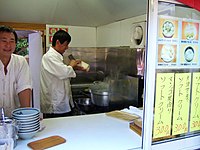Production

Chinese noodles are generally made from either wheat flour, rice flour, or mung bean starch, with wheat noodles being more commonly produced and consumed in northern China and rice noodles being more typical of southern China. Egg, lye, and cereal may also be added to noodles made from wheat flour in order to give the noodles a different color or flavor. Egg whites, arrowroot or tapioca starch are sometimes added to the flour mixture in low quantities to change the texture and tenderness of the noodles' strands. Although illegal, the practice of adding the chemical cross-linker borax to whiten noodles and improve their texture is also quite common in East Asia. In general, the chinese noodles cooking method involves making a dough with flour, salt, and water; mixing the dough by hand to form bar shapes; bending the bars for proofing; pulling the bars into strips; dropping the strips into a pot with boiling water; and removing the noodles when finished cooking. Chinese type noodles are generally made from hard wheat flours, characterized by bright creamy white or bright yellow color and firm texture.
Before the automatic noodle machine was invented in 1950s, the processing of Chinese noodles were made with four steps, including Fresh - The noodles are often consumed within 24 hours of manufacture due to quick discoloration. Their shelf life can be extended to 3-5 days if stored under refrigeration; Dried - Fresh noodle strands are dried by sunlight or in a controlled chamber; Boiled - Fresh noodle strands are either parboiled or fully cooked. After parboiling, Chinese noodles are rinsed in cold water, drained and covered with 1-2% vegetable oil to prevent sticking; Steamed - Fresh alkaline noodle strands are steamed in a steamer and softened with water through rinsing.
The dough for noodles made from wheat flour is typically made from wheat flour, salt, and water, with the addition of eggs or lye depending on the desired texture and taste of the noodles. Rice- or other starch-based noodles are typically made with only the starch or rice flour and water. After the formation of a pliable dough mass, one of five types of mechanical processing may be applied to produce the noodles:
| English | Chinese | Pinyin | Process |
|---|---|---|---|
| Cut | 切 | qiē | The dough is rolled out into a flat sheet, folded, and then cut into noodles of a desired width |
| Extruded | 挤压 | jǐ yā | The dough is placed into a mechanical press with holes through which the dough is forced to form strands of noodles |
| Peeled | 削 | xiāo | A firm dough is mixed and formed into a long loaf. Strips of dough are then quickly sliced or peeled off the loaf directly into boiling water |
| Pulled | 拉 | lā | The dough is rolled into a long cylinder, which is then repeatedly stretched and folded to produce a single thin strand |
| Kneaded | 揉 | róu | A ball of dough is lightly rolled on a flat surface or kneaded with one's hands until it is formed into the desired shape |
| Flicked | 柭 | bó | A soft dough is prepared, placed in a bowl, strips of dough are pulled and flicked directly into boiling water using a flexible bamboo stick or chopstick |
While cut and extruded noodles can be dried to create a shelf-stable product to be eaten months after production, most peeled, pulled and kneaded noodles are consumed shortly after they are produced.

Peeling thin strips of dough from a loaf directly into a container of boiling water to make daoxiaomian (刀削面)
Pulling wheat dough into one thin strand to form lamian
 Play media
Play mediaNoodle maker in Peng Zhou extruding noodles directly into a pot of boiling water.



Comments
Post a Comment